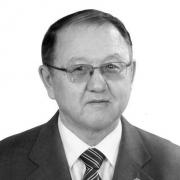
Rakishev Bayan Rakishevich
Academician of NAS RK, Honored Worker of the Republic of Kazakhstan, Rector of KazPTI named after V.I. Lenin in 1985-1992


I think that the choice of my profession was predetermined by the fact that I was born and grew up in a large mining region of Kazakhstan. Our aul was surrounded by Kairaktinsky, Uspensky, Akchatausk, Kenshokinsky mines (Karaganda region).
I finished secondary school in Karaganda, where the miners enjoyed great respect, high authority, and could buy Moskvich for a monthly salary. Mining engineers had the most beautiful uniform. Moreover, at that time the name of the famous mining engineer, the outstanding scientist Kanysh Satpayev, was booming throughout the country.
In September 1952, without exams (as a medalist), I was enrolled in the first year of the mining faculty of KazGMI. I was an excellent student, I liked all fundamental and technical disciplines, from profile ones - the destruction of rocks under the influence of various physical fields and the mechanized development of large mineral deposits.
From the 2nd year I was engaged in research work under the guidance of Associate Professors M.F. Kim (rock destruction), B.I. Tazhenov, M.E. Medvedev (open pit mining). I published the first scientific work "Determination of the deceleration time between charges." The head of the thesis “Open Development of Magnitnaya Mountain” was Associate Professor Mark Efimovich Medvedev.
Student years - a wonderful, memorable time in the human life.
In my student years I was a Stalin scholarship holder, secretary of the Komsomol bureau, chairman of the student scientific society of the faculty and gained some experience in the team. After graduating with honors I worked at the Kunrad mine of the Balkhash mining and smelting plant in 1957-1965, having gone from an analyzer technician to the quarry chief. I submitted and implemented 15 rationalization proposals with great economic effect, published 6 scientific articles.
The knowledge gained within the walls of KazGMI helped to quickly adapt to specific production conditions and confidently improve various technological processes on a serious scientific basis. In 1964, under the leadership of Academician of the Academy of Sciences of the Kazakh SSR Alexander Sergeyevich Popov, I defended my Ph.D thesis. The first opponent of the work was a prominent scientist, Rector of KazGMI - KazPTI in 1952-1962, academician of the Academy of Sciences of the Kazakh SSR Omirkhan Aymagambetovich Baikonurov.
At the end of 1965, I was invited to KazPTI and elected by competition to the post of senior lecturer, in different years I worked as an Associate Professor, Head of the department, Dean of the Faculty of Automation and Computer Engineering, Vice-Rector, and, finally, from 1985 to 1992 I was the Rector of KazPTI. In these years, for the first time in Kazakhstan, specialized student groups were organized in KazPTI for practical training, several branches of the departments and research centers at the enterprises were opened. At that time, about 15 thousand students studied in 38 specialties (8 of which were newly opened).
From 1994 to the present, I have been the scientific director of projects for state scientific and technical programs in the field of mining. I was elected a full member of the International Academy of Sciences and Arts, Academy of Mining Sciences of the Russian Federation, NAS of the Higher School of the Republic of Kazakhstan, Honorary Doctor of Moscow State Mining University, National Mining University of Ukraine, Honorary Professor of several universities of the Republic of Kazakhstan, and I was awarded with numerous orders and medals.
KazNRTU named after K.I. Satbayev is the first research university of the republic. It implements the principle of “learning through research and innovative production”; multifunctionality (training, research, innovative production); primary training of masters and doctors of PhD; development of priority areas of science, high technology and innovation in the economy.
The one who does not use gifts of time has a lot to lose!
In my opinion, SatbayevUniversity in a new format should become an advanced university in the field of higher technical education and science. Ensuring high-quality higher and postgraduate education through the integration of the educational process and scientific research involves their interaction in the framework of scientific and technical programs, scientific and innovative grants, the implementation of a complete innovation cycle from research to the implementation of the results of scientific work into production with wide participation of students and doctoral students.
Entrants of this year are the children of the “century of high technologies”. What does the concept of “high technology” mean in the modern world? These are the most high-tech industries: electronics, robotics, aircraft manufacturing, rocket science, space technology, software, information technology, nanotechnology, nuclear, solar and hydrogen energy, biotechnology, genetic engineering, artificial intelligence and environmentally friendly technologies in all sectors of the economy.
Our students should remember that the basis of any success is a constant work, determination, initiative, perseverance, neglect of arising individual failures in the process of work performance. Student years - a wonderful, memorable time in the human life. This is the time of growing up, comprehensive development, acquiring not only a mass of knowledge, but true friends, skills to work with people. Natural maneuverability, vigorous energy, versatile knowledge make it possible to engage in study, and sports, and literature, and amateur activity, and business. The one who does not use all these (and not only) gifts of time has a lot to lose!






